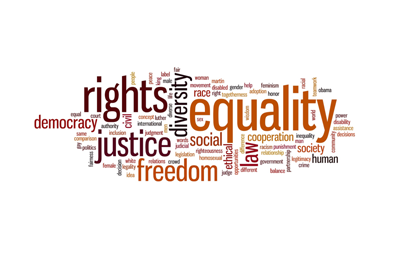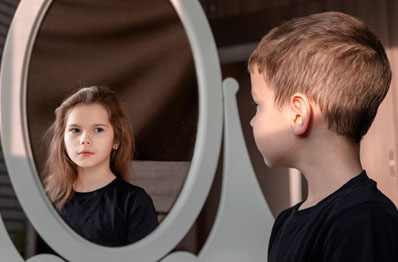EXTRA, EXTRA, READ ALL ABOUT IT
Looking at Current Events with an Analytical Eye
Introduction | Background Knowledge | Activities | Extensions | Standards

Introduction
Students are very in tune with what is happening in their communities. They hear the news and bring thoughts and opinions from home into the classroom. They want to make sense of what is going on. Opening the door to current events can spark many teachable moments in the classroom and bring real-world examples to encourage students to think critically about the world around them.

Background Knowledge
In 1994, America was glued to the trial of OJ Simpson. The media fed the obsession by providing updates continuously. Panels of people would go on television to analyze the trial and their opinions of the situation. Americans watched as the planes hit the Twin Towers and the Pentagon on 9/11 and repeated on demand. During that day, rumors were flying about other targets and other attacks. People did not know what to think or what to believe during the chaos. For the next year, panels of people would go on television to provide their analysis of the response and their opinions of the situation. 2016 brought “fake news” into the national vocabulary. Each day, on various news outlets, panels of people would go on television to provide their analysis and opinions of the newest “fake news” circulating. Throughout the global pandemic of 2020, information changed almost daily as scientists learned more about the coronavirus and provided further guidance to the American people. And each day, panels of people would go on television to provide their analysis of the response and their opinions of the situation. Where do we look? Whom do we listen to? What do we believe? Students must be taught how to look critically at the information they are receiving and then think critically to see the implications of the events taking place.
Critical thinking is not easily defined. Webster’s Dictionary says that critical thinking is “the objective analysis and evaluation of an issue in order to form a judgment.” Being able to analyze and evaluate objectively requires several prerequisite skills. If you take those two components - analyze and evaluate - and put them in the context of Bloom’s Taxonomy, which drives education across the country, they are at the top of the pyramid. To analyze and evaluate, first, a student must be able to remember, understand, and apply. Teachers often skip over those basic levels of Bloom and then expect students to think critically at the higher levels.
Teachers are in a unique position when it comes to critical thinking and current events. Students will come with a variety of viewpoints and background experiences. All suggestions in this piece should be considered carefully. Think about your students and your community before executing lessons incorporating current events. Be responsive to your students’ individual needs and prepare parallel activities for students who are uncomfortable engaging in conversation. You can always incorporate critical thinking activities into your history block. Also, consider your classroom environment and strive to create a safe space for discussion before embarking on activities where students will share vulnerable thoughts.

ACTIVITIES
Skills to Support Critical Thinking
- Ask and answer open-ended questions.
- Use this list to help you ask questions.
-
Connect Different Ideas and Examine the Relationship Between Them
- Create an Online Venn Diagram
- Use a Bridge Map to see relationships. Learn how to use a bridge map here
-
Examine Different Points of View
- Spend 2-3 lessons teaching point of view before asking students to begin to think critically about a topic. ReadWriteThink has a lesson plan - lessons 1-3 are great to get started.
- Collaborate with Others
-
Use Evidence to Create Questions
- Consider using Lateral Thinking Puzzles. Read the story to your students. They can ask yes or no questions only. As they learn information, their questions will become more thoughtful and precise.
We Are the Water Protectors by Carole Lindstrom (ISBN 9781250203557)
- In 2016-2017, Native Americans protested the construction of the Dakota Pipeline. This 1,000-mile pipeline carries oil from North Dakota to Illinois. Thousands of people protested the pipeline because of environmental concerns and the proximity to sacred Native American sites. Standing Rock Reservation was the location of the largest and longest protests.
-
Ask and answer open-ended questions.
- The NEA suggests these open-ended questions to discuss We Are the Water Protectors.
-
Connect Different Ideas and Examine the Relationship Between Them
- Read Raise Your Voice: 12 Protests that Shaped America by Jeffrey Kluger (ISBN 9780525518303). Choose one protest described. Compare and contrast the protest you chose with the Standing Rock Protest.
-
Examine Different Points of View
- While thousands of people protested the Dakota Access Pipeline, many applauded it. Consider the ways that the Dakota Access Pipeline supports Americans. Look at the pipeline through a new lens. Time Magazine presents an unbiased look at the pipeline.
-
Collaborate with Others
- Have a snowball fight. Either prepopulate sheets of paper with cause and effect relationships, arguments and counterarguments, or facts and opinions. Consider statements from a Venn diagram as well. Students have a snowball fight and then pair up to discuss their statements.
-
Use Evidence to Create Questions
- Ask students to research the Dakota Access Pipeline. As they find factual evidence, they can create questions to ask one side of the debate or the other. They can share these questions in the form of a debate in the classroom.
When Aiden Became a Brother by Kyle Lukoff (ISBN 9781620148372)
- Each June, Pride Month is celebrated in America. Beginning as a commemoration of the Stonewall Riots of 1969, it has morphed into a celebration of the LGBTQIA+ community. This month, recognized by the presidential proclamation in 2021, brings awareness, equality, and visibility to the millions of LGBTQIA+ Americans.
-
Ask and answer open-ended questions.
- There are multiple themes in this book. This discussion guide focuses on the forgiveness theme. Lee and Low created a teacher’s guide for the book. The extension questions and the reader’s response questions offer 19 open-ended questions to spark discussion and encourage students to think about Aiden as a brother and as a person.
-
Connect Different Ideas and Examine the Relationship Between Them
- Read Julian is a Mermaid by Jessica Love (ISBN 9780763690458). Compare and contrast Aiden and Julian.
- From the Lee and Low teacher’s guide - explore the concepts of “girl” and “boy.” Prior to reading When Aidan Became a Brother, create a circle with two sections labeled “boy” and “girl” with a line separating them (preferably with dry erase or something that can be removed). Have students come up with characteristics they associate with “boys” and “girls” in their respective sections. After reading When Aidan Became a Brother, ask students if they would change any of the qualities they mentioned. After students make the modifications, erase the middle line in the circle. Ask students why they think the line was erased. What do they think of the circle now? Encourage students to think about how people can be all of these things, not just things specific to “boys” or “girls.”
-
Examine Different Points of View
- Read Sparkle Boy by Leslea Newman (ISBN 9781620142851). Compare Jessie’s point of view with mom’s, dad’s, and Abuela’s. Compare Jessie’s point of view with the boys in the library. Ask students to compare Jessie’s point of view with their own. For a technology approach, use Slido (TeachersFirst review) to engage with the students and allow them to share their thoughts in a poll or through open-ended questions.
-
Collaborate with Others
- Encourage students to write a sequel to this book. What happens after Jessie’s opinion changes? Students can work in pairs or small groups to tell the new story. Try using Elementari (TeachersFirst review) for digital storytelling.
-
Use Evidence to Create Questions
- Encourage students to read “New law protects transgender students” on Newsela (TeachersFirst review). Students can identify the facts in the article and create questions for more research or discussion.
From North to South/Del Norte al Sur by Rene Lainez (ISBN 9780892393046)
- Over 40 million people living in America were born in other places. More people immigrate to America than any other country in the world. Many of these immigrants come to America with proper documentation. Some do not leave when their paperwork expires. Others enter the country without proper documentation. Each presidential administration takes a different stance on immigration, and the topic remains at the forefront of political discussions.
-
Ask and answer open-ended questions.
- Lee and Low created a teacher’s guide for the book. The extension questions and the reader’s response questions offer 24 open-ended questions to spark discussion and encourage students to think about Jose and his family and immigration in America.
-
Connect Different Ideas and Examine the Relationship Between Them
-
Read other books about immigration. Compare the experiences that are portrayed.
- The Arrival by Shaun Tan (ISBN 9780439895293)
- A Different Pond by Bao Phi (ISBN 9781623708030)
- Brothers in Hope: The Story of the Lost Boys of Sudan by Mary Williams (ISBN 9781584302322)
- Lailah’s Lunchbox by Reem Faruqi (ISBN 9780884484318)
- Dreamers by Yuyi Morales (ISBN 9780823440559)
-
Read other books about immigration. Compare the experiences that are portrayed.
-
Examine Different Points of View
- The immigration experience is different for many people. Visit Scholastic’s Immigration Unit to learn about Ellis Island (TeachersFirst review) with an interactive tour and virtual field trip. This site also provides data about immigration and stories from young immigrants. Students can compare and contrast the immigration experience from the height of immigration in the late 1800s to the stories of the young immigrants in these books.
-
Collaborate with Others
- Could you pass the US Citizenship Test? Students work together to answer the questions on the US Customs and Immigration Civics test. Try the official 2008 test or the 2020 questions from USCI. Encourage students to discuss their feelings and thoughts about the experience.
-
Use Evidence to Create Questions
- Examine the Immigration Myths Lesson (TeachersFirst review) to encourage students to analyze and question the myths.
The Fog by Kyo Maclear (ISBN 9781770494923)
- Climate change has a long-term impact on the Earth’s global weather patterns and climate. Weather events - stronger hurricanes, droughts, storms, etc. - become more severe and more frequent. Human activity is the leading cause of climate change.
-
Ask and answer open-ended questions.
- PBS presents a lesson plan about climate change, including footage of congressional hearings and complementary articles. The resource is old, dated in 2005, but the questions and conversations can lead to research into the current state of the environment.
- This archived article from the EPA offers the answers to the questions, but they are great questions to open discussion.
-
Collaborate with Others
- Encourage students to have a conversation about climate change with this resource designed for English Language Learners. Split students into two groups - an A group and a B group. Each A will have a set of questions, and each B will have a set of different questions. Pair an A with a B and encourage the students to ask and answer each other's questions.
-
Use Evidence to Create Questions
- Explore the NASA Climate Change website (TeachersFirst review). Use the information to create questions about climate change.
-
Bring in experiments (see list below) to see how climate changes impact the Earth. Use the background knowledge of climate change to create research questions and then complete the experiments to answer the questions.
- Air Pollution
- The Effect of Ice Cap Melting on Polar Bears
- Comparing Ice Melt at the North Pole and the South Pole
- What Melts Ice Faster? Land or Water?
- If you cannot complete the experiment, you can use this video.
A Place Inside of Me by Zetta Elliott (ISBN 9780374307417)
- On April 29, 1992, a Ventura County jury acquitted the police officers who beat Rodney King after a traffic stop. The acquittal was the beginning of years of conversations about police brutality. It was also the beginning of 5 days of unrest in Los Angeles, now known as the LA Riots. The discussion about police brutality and racial injustice has spanned decades, peaking again in the summer of 2020 after George Floyd was killed under the knee of a former Minneapolis police officer for trying to pass a counterfeit $20 bill.
-
Ask and answer open-ended questions.
-
Unleashing Readers presented three questions in the review of this book.
- How do the author and illustrator depict the emotions within the text?
- What nuances do you see in the different emotions?
- How can we use this text to enact change in our community?
-
Unleashing Readers presented three questions in the review of this book.
-
Connect Different Ideas and Examine the Relationship Between Them
- Compare the emotions presented concerning the initial shooting to other times students have felt those emotions. Compare the events. (For example, the book says, “there is pride inside of me.” Students can identify another time they felt proud. Then they can compare and contrast their experiences with the experiences presented in the book.
-
Examine Different Points of View
- Show a video of the author reading the book. What is her point of view?
- Collaborate with Others Working in pairs or small groups, choose a different moment or event. This event can be personal or connected to the content. Describe the moment or event through the lens of emotions.
-
Use Evidence to Create Questions
- As Zetta Elliott points out in her commentary and reading of the book, notice the pictures. Students, with assistance, can identify elements in the images. Once they identify elements, they can learn more and use their findings to ask questions.

EXTENSIONS
-
Extend the conversation to chapter books.
-
We Are the Water Protectors
- In the Footsteps of Crazy Horse by Joseph Marshall III (ISBN 9781419707858)
-
When Aiden Became a Brother
- The Other Boy by M.G. Hennessey (ISBN 9780062427670)
-
From North to South
- Front Desk by Kelly Yang (ISBN 9781338157826)
-
The Fog
- Flush by Carl Hiaasen (ISBN 9780375861253)
-
A Place Inside of Me
- Ghost Boys by Jewell Parker Rhodes (ISBN 9780316262262)
-
We Are the Water Protectors
-
Connect to research to learn more about the current events.
-
Students can find more information from reliable sources about any current event. They can present their facts and their thoughts in a variety of ways.
-
Technology Approach
- Create a podcast. Learn more from OK2Ask and TeachersFirst’s TwitterChat.
-
Record a podcast using PodBean (TeachersFirst review)
-
Non-technology Approach
- Facing History and Ourselves has many activities to prompt critical thinking using current events and follow-on research.
-
Technology Approach
-
Students can find more information from reliable sources about any current event. They can present their facts and their thoughts in a variety of ways.

CORRELATION TO STANDARDS
-
AASL National School Library Standards
- Inquire Shared Foundation, Create Domain - Learners engage with new knowledge by following a process that includes: 1. Using evidence to investigate questions
- Inquire Shared Foundation, Grow Domain - Learners participate in an ongoing inquiry-based process by: 3. Enacting new understanding through real-world connections. 4. Using reflection to guide informed decisions.
- Include Shared Foundation, Think Domain - Learners contribute a balanced perspective when participating in a learning community by: 2. Adopting a discerning stance toward points of view and opinions expressed in information resources and learning products. 3. Describing their understanding of cultural relevancy and placement within the global learning community.
- Include Shared Foundation, Include Domain - Learners exhibit empathy with and tolerance for diverse ideas by: 1. Engaging in informed conversation and active debate. 2. Contributing to discussions in which multiple viewpoints on a topic are expressed.
- Collaborate Shared Foundation, Grow Domain - Learners actively participate with others in learning situations by: 1. Actively contributing to group discussions. 2. Recognizing learning as a social responsibility
- Curate Shared Foundation, Think Domain - Learners act on an information need by: 3. Making critical choices about information sources to use
- Curate Shared Foundation, Create Domain - Learners gather information appropriate to the task by: 1. Seeking a variety of sources. 2. Collecting information representing diverse perspectives. 3. Systematically questioning and assessing the validity and accuracy of information.
- Engage Shared Foundation, Think Domain - Learners follow ethical and legal guidelines for gathering and using information by: 3. Evaluating information for accuracy, validity, social and cultural context, and appropriateness for need.
-
ISTE Standards for Students
- Knowledge Constructor -. 3b. Students evaluate the accuracy, perspective, credibility and relevance of information, media, data or other resources
- Knowledge Constructor - Knowledge Constructor 3d. Students build knowledge by actively exploring real-world issues and problems, developing ideas and theories and pursuing answers and solutions
